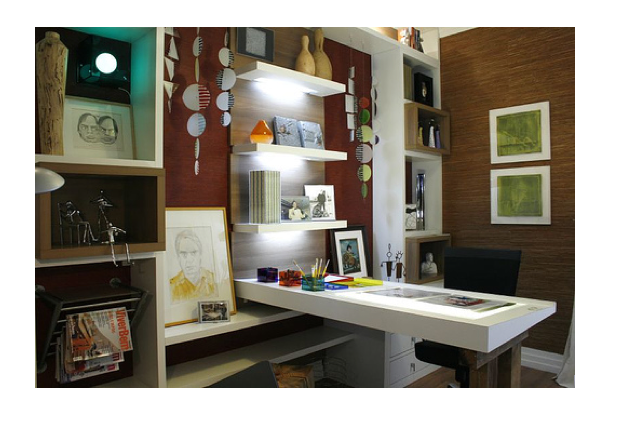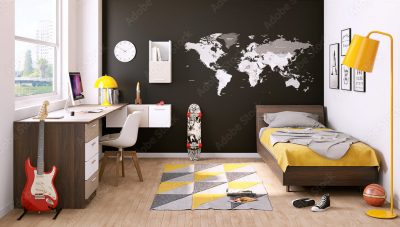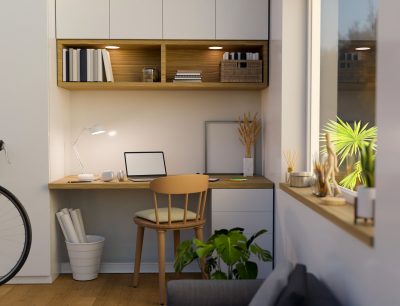
“[Clutter] robs us spiritually, because we can’t be at peace in a cluttered home. And it robs us psychologically, by stealing our ability to feel motivated in our space.” – Peter Walsh
A quick way to get reinvigorated about your business is to make room for what you really enjoy. Let’s start with a scan of your office space and resource library – approach it like a re-design project and edit what isn’t working!
I’m a huge proponent of having systems in place that work for you, not necessarily every designer you meet. I also believe you already have several types of systems and processes in action; they just have varying levels of effectiveness and efficiency.
1. Look around your desk and office space. What areas represent your biggest pain points? Focus on these areas first (e.g. resource catalogs, samples, computer files, tear sheets, client files).
2. Ask yourself why you find these areas to be such a challenge. Are you lacking a system? Have you run out of space? Are you short of the time you need to get to it?
3. If you think you’re lacking a system, you’re probably right! Here are a few tips to coming up with a system that works for you:
- Create filing systems that make sense for your design business and will support the business of design. Some examples: In and out file sorters (especially helpful if you’re working with an assistant or intern); hot file for urgent and important tasks and activities; client files with items you review with your client versus client files with purchase order, specification and sourcing information; order processing files to keep track of what needs to be ordered, orders entered but needing more details (such as confirmation numbers, pricing, shipping dates), back orders, and items returned awaiting credit.
- Categorize your design ‘stuff’ – resources, catalogs, samples, vendor and rep business cards, even bookmarks on your computer – with consistent categories and groupings. So many designers either overcomplicate this or don’t group items at all. Either way, this can lead to lots of clutter, outdated information and mass confusion (again, especially if you’re working with an assistant or intern). I’ve found it helpful to refer to TODL.com, the Trade Only Design Library, for product categories.
- Hire a professional organizer, or enlist the help of a design assistant. Sometimes a different set of eyes will bring a completely new perspective.
4. So you just don’t have enough space? Really? This is the time to be completely honest with yourself. The space is there, you just need to find it! 3 words: Purge, Sort, and Store.
Purge
- You’ve seen the television programs; you’ve probably even read a few books on this topic. It all starts with the purge – and it begins in the area you’ve identified as your biggest pain point. Afraid to “purge” and let go? Think of it this way; you are clearing what no longer fits your vision of you as a designer and you as a business owner; you are creating breathing room, you are giving your mind space to imagine the life and business you want, and you are giving yourself permission and creative license to focus on what’s really important to you and get it. (I’m guessing it’s not about the stuff now, is it?)
- Set aside a time to do your purge. For some, setting a timer for 15 minutes of purge time is a great way to get started. For others, scheduling an entire day or 2 may be better. Do what works for you.
- Have your supplies ready, such as trash bags, boxes and containers, recycling bins. You’ll need separate containers for items that you’ll keep, dispose of, recycle or donate.
- Purge! I like the 1-touch rule – when you pick something up, make a decision right then and there about what you’re going to do with it – into the keep, donate, recycle or trash container it goes.
Sort
- Yes, you did some sorting in the Purge step, but this is when you take inventory of what is now in your keep container(s). Look at these items, and then look at the area you removed them from. Do they truly belong in that area? Remember, this was the spot you identified as your biggest pain point. Chances are many of your ‘keep’ items from this area belong in another zone better suited to the function.
- Sort items according to function, and identify specific zones for each function. This is key to organizing your office space for the business you want. For example, have all your pens & paper landed on a cabinet across the room from your desk because that’s where they fit when you first set up your office? Position items where they belong – where you need them.
Store
- You’ve probably identified a few zones for items in your office, such as mail, catalogs, magazines, samples, accounting, client files, and projects. Locate like items and functions together.
- Utilize vertical space and stackable containers to maximize space and create additional efficiency in your zones.
- You’re a designer, so organize by color! There are tons of fantastic storage options available, so color coding by function and zone is easier than ever.
- Back to positioning items where you need them; be sure to store items you use the most where it is easiest for you to get to them.
5. There aren’t enough hours in the day. I know, I never seem to get to everything on my list either, especially when it includes things that frankly aren’t that important! So what’s important to you? Look beyond the stuff and perceived time crunch and imagine not only the life you could be living but the business you could have. Do you have 15 minutes?
- Set a timer for 15 minutes and get started. If you can only make time for 15 minute increments each day, that’s fine. (Although I’ll bet you’ll find yourself setting aside more time as you get into it!)
- Self-discipline challenges? Implement the buddy system. Enlist the help of a professional organizer or assistant and you’ll get more done in less time.
- Consider an office organizing day. Schedule it and treat this time like you would a client appointment. After all, you’re creating a space and systems to support your vision of your business. Isn’t that worth you booking an appointment with you?
So for all you self-proclaimed unorganized or scattered creative types; let go of the comparisons and excuses for not being Martha Stewart-like in your approach. Embrace your individual work style but set yourself up for success by following these simple steps.
In Order to Succeed offers home staging services in Greenwich CT, Manhattan NY, Sarasota FL, the Hamptons NY, Minnesota Lakes, and more.
by: Kelly Galea
Guest Blogger Kelly has worked both as the owner of an interior design firm and as a professional organizer. Currently, as The Design Biz Coach, Kelly helps interior designers, decorators & home stagers build and grow their businesses.
Further Reading
The Design Biz Coach
My Design Connections
In Order To Succeed
Photo courtesy of: http://www.flickr.com/photos/arquitetamovel/ / CC BY 2.0





 Or check out holiday decorations in your nearby city or town, by foot. If you didn’t learn during the height of the pandemic that walking is good for stress and your soul, it’s not too late. You can even refer to this activity with a fancy name,
Or check out holiday decorations in your nearby city or town, by foot. If you didn’t learn during the height of the pandemic that walking is good for stress and your soul, it’s not too late. You can even refer to this activity with a fancy name, 


 In most dorms, the bed and desk will take up the bulk of the floor space, but you can bet there will still be plenty of room on the walls. Over-the-door shoe holders are great for storing your favorite footwear, and they can also double for storing other objects.
In most dorms, the bed and desk will take up the bulk of the floor space, but you can bet there will still be plenty of room on the walls. Over-the-door shoe holders are great for storing your favorite footwear, and they can also double for storing other objects. 


 Taking the time to put together organized drawers will save you so much room in the long run. Using acrylic bins is a great way to turn this idea into a reality! You’ll have a specific place for everything, which is the best way to keep your space clean. Make time at least once a week to tidy up your room so that you can ensure the space stays clean.
Taking the time to put together organized drawers will save you so much room in the long run. Using acrylic bins is a great way to turn this idea into a reality! You’ll have a specific place for everything, which is the best way to keep your space clean. Make time at least once a week to tidy up your room so that you can ensure the space stays clean.  Drawers are ideal for dealing with dorm room storage. They keep everything out of your way, but they don’t take up a ton of space. In fact, if you need to, you can even get separate storage cubes and stack them all up. Either way, using several drawers is a fantastic way to store everything.
Drawers are ideal for dealing with dorm room storage. They keep everything out of your way, but they don’t take up a ton of space. In fact, if you need to, you can even get separate storage cubes and stack them all up. Either way, using several drawers is a fantastic way to store everything. 
